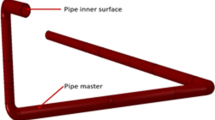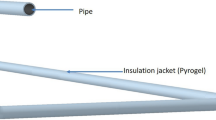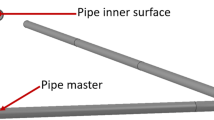Abstract
The geometrical increase in the demand for electrical energy has posed serious pressure on the power generation components such as the steam pipes due to the consequential increase in the operating parameters such as temperature and pressure. This increment in operating parameters tends to limit the useful life of these pipes. Thus, high creep resistant materials such as X20 CrMoV12-1 and P91 (9Cr-1Mo) are used to manufacture steam pipes. In this paper, the creep behaviour of X20 CrMoV12-1 and P91 (9Cr-1Mo) steam piping network subjected to typical operating condition was determined via a finite element analysis code, Abaqus CAE/2017 alongside fe-safe/Turbolife software, and their results were compared. The maximum creep stress, strain rate, creep damage and worst creep life in both piping materials were developed on the intrados of the elbow, with P91 steam pipe having higher useful creep life. Furthermore, a good correlation was achieved between the result of the analytically calculated and numerically simulated creep rate at the straight section of the piping networks.
















Similar content being viewed by others
References
Hu Z-F(2012) Heat-resistant steels, microstructure evolution and life assessment in power plants. Thermal power plants 195-226.
Bharasi NS, Thyagarajan K, Shaikh H, Radhika M, Balamurugan A, Venugopal S, Venugopal S, Moitra A, Kalavathy S, Chandramouli S, Tyagi AK, Dayal RK (2012) Evaluation of microstructural, mechanical properties and corrosion behavior of AISI type 316LN stainless steel and modified 9Cr-1Mo steel exposed in a dynamic bimetallic sodium loop at 798 K (525 C) for 16,000 hours. Metall Mater Trans A 43(2):561–571
Bocquet P, Bourges P, Cheviet A (1993) Properties of heavy components of steel grade 91 and their welds. Nucl Eng Des 144(1):149–154
Sireesha M, Sundaresan S, Albert SK (2001) Microstructure and mechanical properties of weld fusion zones in modified 9Cr-1Mo steel. J Mater Eng Perform 10(3):320–330
Mariappan K, Shankar V, Bhaduri AK (2020) Comparative evaluation of tensile properties of simulated heat affected zones of P91 steel weld joint. Mater High Temp
Xu Q, Yang X, Lu Z (2017) On the development of creep damage constitutive equations: a modified hyperbolic sine law for minimum creep strain rate and stress and creep fracture criteria based on cavity area fraction along grain boundaries. Mater High Temp 34(5-6):323–332
Xu Q, Lu Z, Wang X (2017) Damage modelling: the current state and the latest progress on the development of creep damage constitutive equations for high Cr steels. Mater High Temp 34(3):229–237
Montes J, Cuevas F, Cintas J (2012) New creep law. Mater Sci Technol 28(3):377–379
Garofalo F (1963) An empirical relation defining the stress dependence of minimum creep rate in metals. Trans Metall Soc AIME 227(2):351–355
Reggiani R, Donati L, Tahar MB, Tomesani L (2018) Experimental investigation of hot-work tool steels performances under the creep-fatigue regime. Int J Adv Manuf Technol 94(5-8):1957–1967
Xue J, Zhou C (2016) Finite element creep damage analyses and life prediction of P91 Pipe Containing Local Wall Thinning Defect. High Temp Mater Processes 35(3):283–295
Tu S-T, Segle P, Gong J-M (2004) Creep damage and fracture of weldments at high temperature. Int J Press Vessel Pip 81(2):199–209
Hyde TH, Sun W, Williams JA (1999) Prediction of creep failure life of internally pressurised thick walled CrMoV pipes. Int J Press Vessel Pip 76(14-15):925–933
Hyde TH, Sun W, Williams JA (2002) Life estimation of pressurised pipe bends using steady-state creep reference rupture stresses. Int J Press Vessel Pip 79(12):799–805
Hall FR, Hayhurst DR (1991) Continuum damage mechanics modelling of high temperature deformation and failure in a pipe weldment. Proceedings of the Royal Society of London. Series A: mathematical and physical sciences 433(1888):383–403
Kachanov LK 1958 Rupture time under creep conditions.
Kowalewski ZL, Hayhurst DR, Dyson BF (1994) Mechanisms-based creep constitutive equations for an aluminium alloy. J Strain Anal Eng Des 29(4):309–316
Yang FQ, Xue H, Zhao LY and Tian J (2014) Calculations and modeling of material constants in hyperbolic-sine creep model for 316 stainless steels," vol. 457, pp. 185-190: Trans Tech Publ.
Annaratone D (2007) Cylinders under internal pressure. Pressure Vessel Design:47–125
Kanlıkama B, Abuşoğlu A, Güzelbey İH (2013) Coupled thermoelastic analysis of thick-walled pressurized cylinders. International Journal of Energy and Power Engineering 2(2):60–68
Kandil A, El-Kady A, El-Kafrawy A (1995) Transient thermal stress analysis of thick-walled cylinders. Int J Mech Sci 37(7):721–732
Pesonen V (2014) Online creep and fatigue monitoring in power plants.
Skelton R, Gandy D (2008) Creep–fatigue damage accumulation and interaction diagram based on metallographic interpretation of mechanisms. Mater High Temp 25(1):27–54
Xu L, Zhao L, Gao Z, Han Y (2017) A novel creep–fatigue interaction damage model with the stress effect to simulate the creep–fatigue crack growth behavior. Int J Mech Sci 130:143–153
Wen J-F, Tu S-T (2014) A multiaxial creep-damage model for creep crack growth considering cavity growth and microcrack interaction. Eng Fract Mech 123:197–210
Robinson EL (1952) Effect of temperature variation on the long-time rupture strength of steels. Trans ASME 77
Liu D, Pons DJ, Wong E (2017) Creep-integrated fatigue equation for metals. Int J Fatigue 98:167–175
Rasiawan T (2017) The influence of prior creep damage on the fracture localisation in X20 CrMoV12-1 cross-weld creep tests: University of Cape Town.
Salifu S, Desai D, Kok S (2020) Creep–fatigue interaction of P91 steam piping subjected to typical start-up and shutdown cycles. J Fail Anal Prev
Pyrogel-XTE-Datasheet. High-performance aerogel insulation for industrial and commercial applications.
Salifu S, Desai D, Kok S, Ogunbiyi O (2019) Thermo-mechanical stress simulation of unconstrained region of straight X20 steam pipe. Procedia Manufacturing 35:1330–1336
Salifu S, Desai D, Fameso F, Ogunbiyi O, Jeje S, Rominiyi A (2020) Thermo-mechanical analysis of bolted X20 steam pipe-flange assembly. Materials Today: Proceedings.
Matweb MPd. X20Cr13 Stainless steel for medical instruments 2019 [updated 2019. Available from: http://www.matweb.com/search/datasheet_print.aspx?matguid=81346c1935fc4e03bf5e1ee21d20c218.
Salifu S, Desai D, Kok S (2020) Numerical investigation of creep-fatigue interaction of straight P91 steam pipe subjected to start-up and shutdown cycles. Materials Today: Proceedings.
Zhang Z, Kovacevic R (2019) A thermo-mechanical model for simulating the temperature and stress distribution during laser cladding process. Int J Adv Manuf Technol 102(1-4):457–472
Dassault Simulia Systemes (Providence, RI,. 2013) ABAQUS 6.13 User’s manual.
Salifu S, Desai D, Kok S (2020) Numerical simulation and creep-life prediction of X20 steam piping. Materials Today: Proceedings.
Naumenko K, Altenbach H, Kutschke A (2009) A constitutive model for creep and long-term strength in advanced heat resistant steels and structures. Journal of Transition 2(3):4
Gorash Y, MacKenzie D (2017) On cyclic yield strength in definition of limits for characterisation of fatigue and creep behaviour. Open Engineering 7(1):126–140
Dassault Simulia Systemes (Providence, RI, 2017) fe-safe/TURBOlife user manual p. 12229.
Acknowledgement
This research has been profusely supported by Tshwane University of Technology and the University of Pretoria, South Africa. Also, the authors received relentless support of Eskom Power Plant Engineering Institute (Republic of South Africa).
Author information
Authors and Affiliations
Corresponding author
Additional information
Publisher’s note
Springer Nature remains neutral with regard to jurisdictional claims in published maps and institutional affiliations.
Rights and permissions
About this article
Cite this article
Salifu, S., Desai, D. & Kok, S. Comparative evaluation of creep response of X20 and P91 steam piping networks in operation. Int J Adv Manuf Technol 109, 1987–1996 (2020). https://doi.org/10.1007/s00170-020-05727-7
Received:
Accepted:
Published:
Issue Date:
DOI: https://doi.org/10.1007/s00170-020-05727-7




